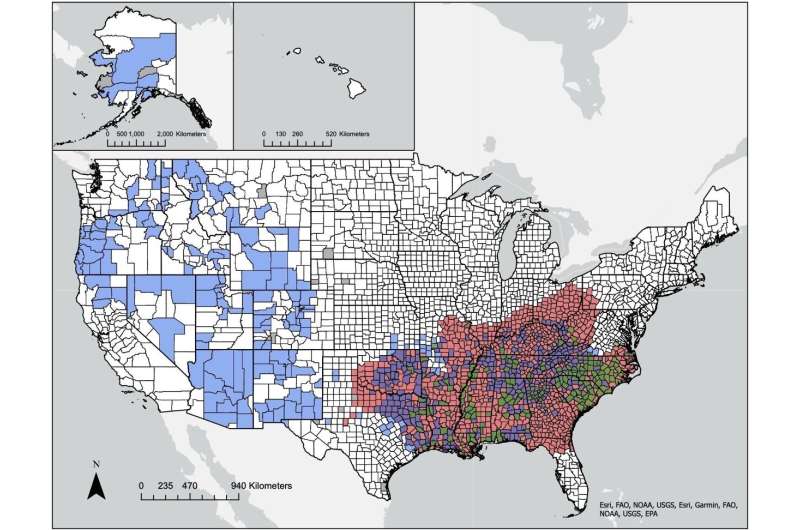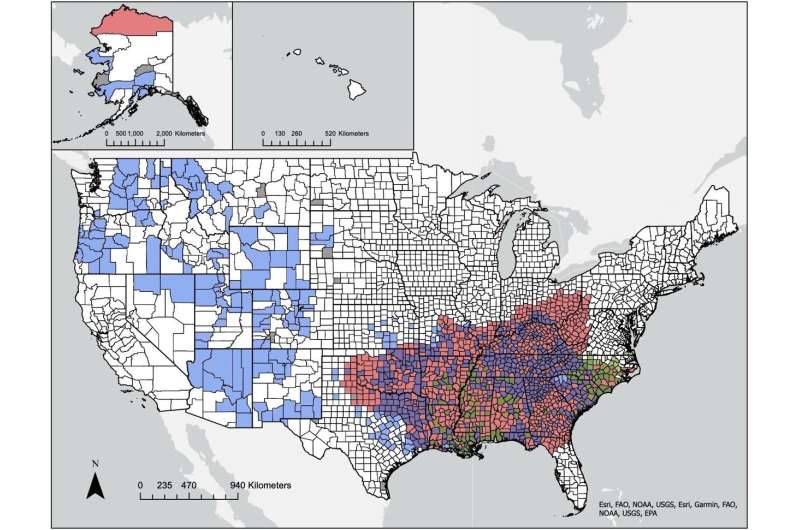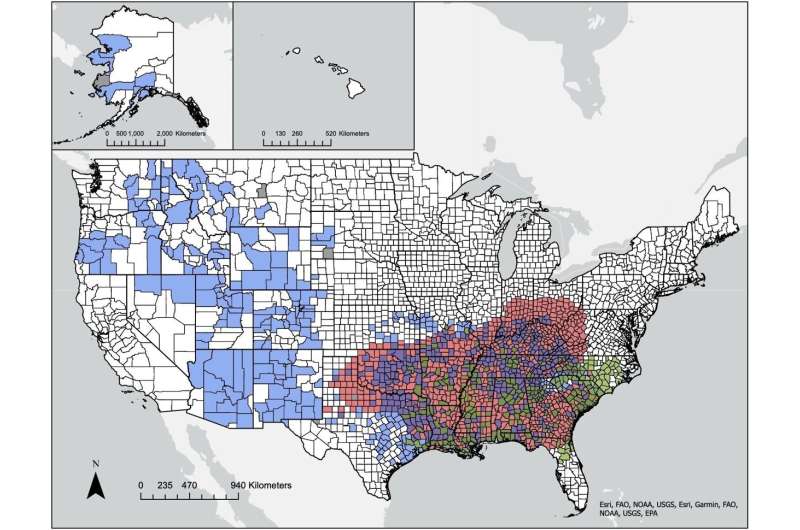
Smoking and firearms are among the leading causes of avoidable premature death in the United States. In 2021, 480,000 deaths in the U.S. were attributable to tobacco and more than 40,000 to firearms—both are legal yet lethal.
A new study from Florida Atlantic University's Schmidt College of Medicine, and collaborators, now reveals geographically distinct areas of the highest death rates in the U.S. related to cigarettes as well as firearms, including both assault and suicide over two decades.
Results, published in Preventive Medicine, show all three measures—smoking, firearm-related assault and firearm-related suicide—clustered in the Southeastern U.S. with significantly higher rates compared to the U.S. overall.
From 1999 to 2019, firearm assault-related and suicide-related mortality increased 16 percent in the U.S. and 25 percent in the Southeast. For smoking-related mortality, rates have decreased significantly over the course of the last 20 years but "hot spots" of increased mortality persist in the Southeast, West and Alaska. Firearm mortality also had "hot spots" in the Southeast, West and Alaska.
States with hot spots of all three measures included Florida, Alabama, Georgia, South Carolina, North Carolina, Mississippi, Louisiana, Arkansas, Texas, Oklahoma, Missouri, Kentucky, Virginia and West Virginia. The largest number of overlapping counties were located in North Carolina and South Carolina. This contrasts with the Western U.S. where there was no overlap and hot spots were located solely for firearm-related suicide.
"These data are descriptive not hypothesis testing but may aid health care providers and policy makers, especially in areas of highest risks," said Charles H. Hennekens, M.D., Dr.PH, senior author, first Sir Richard Doll Professor of Medicine, senior academic advisor to the dean, and interim chair, Department of Population Health and Social Medicine, in FAU's Schmidt College of Medicine, and an adjunct professor of family and community medicine at Baylor College of Medicine.
Researchers used data from the U.S. Centers for Disease Control and Prevention Wide Ranging Online Data for Epidemiologic Research (WONDER) as well as the Multiple Cause of Death files. Using age-specific rates, they generated geospatial maps of hots spots across three time periods: 1999 to 2005; 2006 to 2012; and 2013 to 2019. Overlapping maps with all three exposures were generated for each of the three time periods displaying hot spots.
"Both smoking and firearm-related mortality rates remain higher in the Southeast compared to the entirety of the U.S. with the patterns largely unchanged over the two decades of observation," said Sarah A. Palumbo, M.D., first author, a recent M.D. graduate and a first-year resident in internal medicine in FAU's Schmidt College of Medicine.
Hot spots from 1999 to 2005:
- Smoking-related deaths: 1,268 counties identified as hot spots primarily in the Southeast extending up to the Appalachian corridor. The county with the highest rates was in South Dakota.
- Firearm-related deaths from assaults: 190 counties identified as hot spots within a single region in the Southeast. The county with the highest rates was in Louisiana. In Florida, two hot spots were in two northern counties.
- Firearm-related deaths from suicide: 602 counties identified as hot spots primarily in the Southeast, the West and Alaska. The county with the highest rates was in Alaska.

Hot spots from 2006 to 2013:
- Smoking-related deaths: 1,194 counties identified as hot spots primarily in the Southeast with minimal changes from 1999 to 2005. The county with the highest rates was in Kentucky.
- Firearm-related deaths from assaults: 131 counties identified as hot spots predominantly in the Southeast, with minimal changes from 1999 to 2005. The county with the highest rates continued to be in Louisiana. The hot spot in the Southeast still excluded most of Florida.
- Firearm-related deaths from suicide: 693 counties identified as hot spots, especially in the Southeast and the West with minimal changes from 1999 to 2005. The county with the highest rates was in Alaska.

Hot spots from 2013 to 2019:
- Smoking-related deaths: 1,135 counties were identified as hot spots primarily in the Southeast with some southern expansion. The county with the highest rates was in South Dakota.
- Firearm-related deaths from assaults: 254 counties identified as hot spots in the Southeast with some expansion of the region. The county with the highest rate was in Virginia. The hot spot in the Southeast expanded further south into Florida and further northwest.
- Firearm-related deaths from suicide: 764 counties identified as hot spots with a major region still observed in the Southeast and minimal changes from 2006 to 2013. The county with the highest rates was in Alaska.
More information: Sarah A. Palumbo et al, Temporal trends and geographic variations in mortality rates from tobacco and firearms in the United States, Preventive Medicine (2023). DOI: 10.1016/j.ypmed.2023.107622
https://medicalxpress.com/news/2023-08-geographic-hot-cigarette-firearm-deaths.html
No comments:
Post a Comment
Note: Only a member of this blog may post a comment.